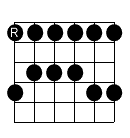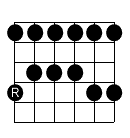Root Notes
You’ll notice that there are 12 major key signatures and 12 minor key signatures. That doesn’t mean you have to learn 24 scales. You only need to learn one pattern to get started. You simply have to move the pattern up or down the fretboard in order to change keys.
In the diagram below you can see a visual representation of a pentatonic minor scale pattern. The root note of the scale is marked by an “R”.

Since the pattern is the same for any key we must simply match the root note to the note on the 6th string that matches the name of the key. See the chart below.
| Fret | 1 | 2 | 3 | 4 | 5 | 6 | 7 | 8 | 9 | 10 | 11 | 12 |
| Key | F | F#/Gb | G | G#/Ab | A | A#/Bb | B | C | C#/Db | D | D#/Eb | E |
As scale pattern can have it’s root note in a different place other than the lowest note. This pentatonic major scale pattern has it’s root note in a place other than the lowest note. It’s the second note on the bottom string as illustrated below:

| Fret | 1 | 2 | 3 | 4 | 5 | 6 | 7 | 8 | 9 | 10 | 11 | 12 |
| Chord | – | – | (open) G | G#/Ab | A | A#/Bb | B | C | C#/Db | D | D#/Eb | E |